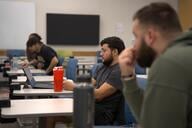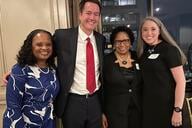You have /5 articles left.
Sign up for a free account or log in.
The achievements of the health-care industry during the coronavirus pandemic have been nothing short of extraordinary and an excellent example of how a robust higher education system benefits all Americans. Colleges and universities have long been a chief producer of the public good -- in this case, the professionals working to develop and distribute a vaccine, to keep us informed and our hospitals and research facilities running, and to provide medical care, were once college students. Higher education powers our economy and society through advancements in science and technology, achievements in the arts, the promotion of public thought, and the training of the next generation of leaders. Truly amazing things are happening on campuses every day.
But many Americans no longer see it that way.
In 2013, 70 percent of Americans viewed a college education as “very important.” That number has dropped nearly 20 points in recent years. Moreover, nearly 40 percent of Americans thought that colleges and universities were having a negative effect on the way things were going in the country in 2019. More than half believe that the higher education system in the U.S. is going in the wrong direction; the cost of tuition and the perception that students are not getting the skills they need for the workplace are identified as the key reasons for this view. This perilous decline in public esteem over the past decade has serious consequences. Persistent negative attitudes harbored by voters have empowered lawmakers to govern in kind. State budgets for higher education already reflect these changing priorities.
What’s most frustrating is that the caricature of higher ed ridiculed on cable television now overshadows the realities of campus life. On a typical day at my college, you’d find faculty members who care deeply about educating students and conducting research to benefit the world around them. You’d also find an inspirational group of young people working hard in labs and classrooms to hone the skills needed to build careers and contribute to their communities. These stories never seem to make it further than a college magazine or alumni newsletter. This needs to change.
It’s time we took back the narrative. We must do a better job of telling our story to the public, specifically to our local and state communities. It’s not about changing what we do for media coverage and public consumption, but rather being intentional about communicating that work with the world outside our campus communities. This will require a collective effort among groups of faculty, staff and administrators.
Colleges and universities already hold a competitive advantage when it comes to gaining earned media. Reporters want expert sources, and we have campuses full of aspiring and full-fledged experts. National media hits will still be rare and out of reach for most, but if colleges create something that directly benefits or answers a question for the local community, local outlets will come. And, in many ways, that’s even better: local news earns higher levels of trust than national news across party lines. Their airwaves are exactly where colleges should want to be.
So, how do we do it?
For starters, it means faculty including a public-facing product, such as an op-ed in a newspaper or commentary on a local public affairs radio show, to complement their scholarship. Whenever possible, faculty should develop programs and research agendas rooted in analyzing problems in the proximate geography of the institution’s location. This can be lending expertise to a local nonprofit, researching a statewide policy problem with a team of students or even organizing and moderating a public forum.
And faculty need not pursue this on their own. College communications staff are crucial in the efforts to turn faculty and student work into something of interest to a broader audience that they can pitch to media outlets. To close the loop, faculty need to tell their campus communications office about their work, listen to their expertise and advice, and participate when opportunities arise.
Administrators must match faculty efforts to engage in public outreach through offering research grants and opportunities for professional media training. After all, it’s free media exposure for the institution, an important consideration with the high cost of ad campaigns and dwindling marketing budgets. Most importantly, this public outreach work must be formally recognized as service to the institution and considered part of the faculty member’s workload.
To be sure, improving how we tell the story of American higher education won’t fix academia’s public opinion problem alone or overnight. But purposeful engagement at the local and regional level will pay off -- for the faculty who elevate their status as experts, for boosting individual institutional reputation, and for the greater good of higher education. Knowledge sharing, research and teaching is a benefit to our country and the public good. And it’s time we work together to tell that story.
Mileah Kromer is an associate professor of political science and the director of the Sarah T. Hughes Field Politics Center at Goucher College. The Hughes Center conducts the Goucher College Poll, a highly cited survey of Maryland residents and voters.




